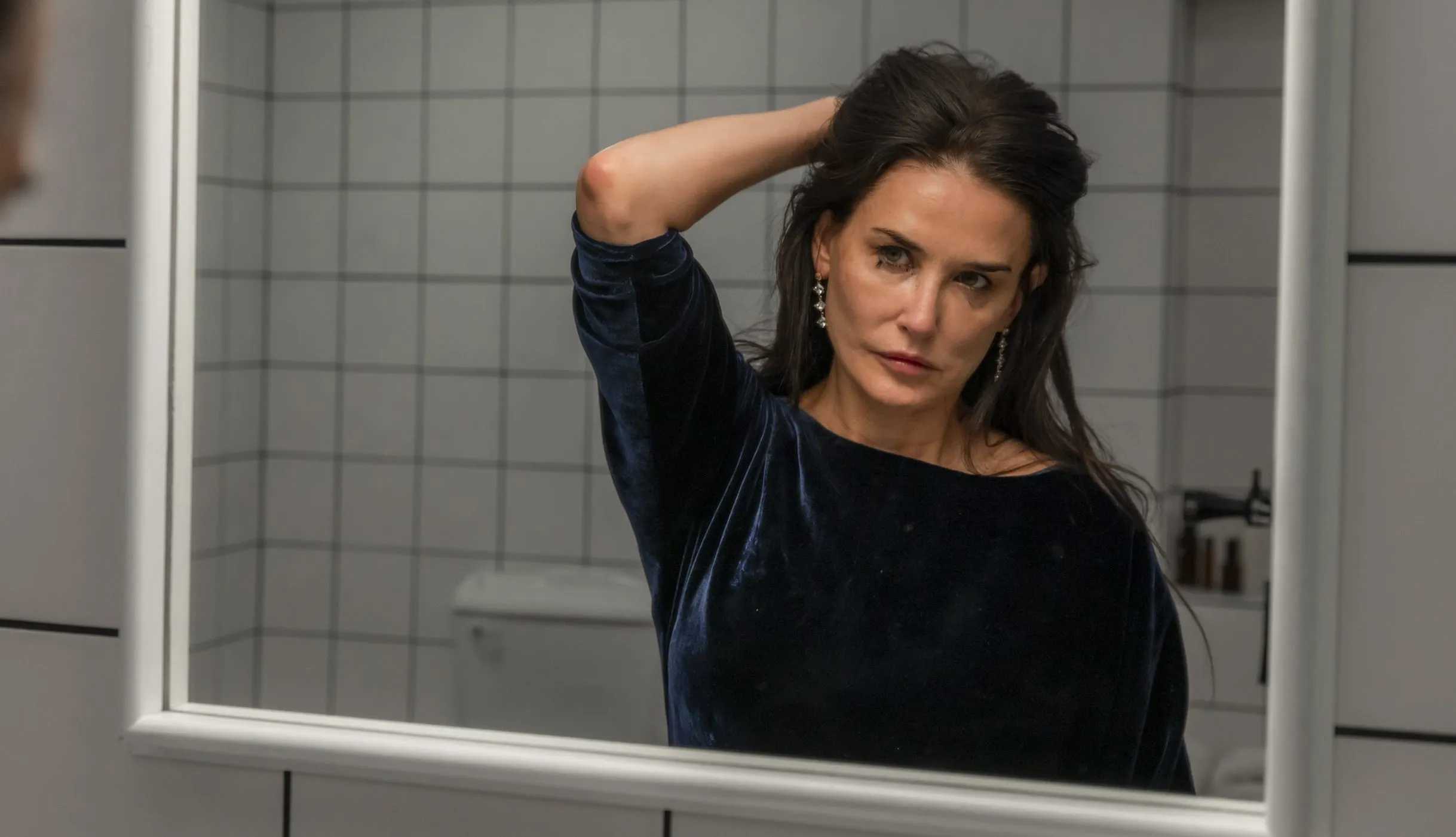In her shock spectacle The Substance, Coralie Fargeat delivers a bold, blood-soaked critique of the absurd beauty standards imposed on modern women, powered by a trenchant Demi Moore as a discarded former Hollywood star who takes a black market fountain of youth drug with disastrous results. The winner of this year’s screenplay prize at Cannes, it is an unnerving confrontation with the social and psychological effects of objectification and ageism and an instant cult classic.
Audaciously mounted and conceived, The Substance is so technically accomplished and thematically fearless that it’s impossible to look away, even when it teeters on the edge of excess. Audiences will be polarized—entertainment seekers may come away wondering what in the hell just hit them, while those comfortable with genre straddling social horror will be thrilled.
Fargeat, whose 2017 debut Revenge was an unsettlingly stylish rape-revenge tale, opens The Substance with a striking shot—that of Elisabeth Sparkle’s (Moore) newly installed star on the Hollywood Walk of Fame, glistening at first, then revealing the passage of time as cracks and wear creep into its surface, a mirror of her soon-to-be public image.
Once Oscar winner Elisabeth is now the face of a daytime TV fitness show named Sparkle Your Life, leading Jane Fonda-esque motivational workouts. Her boss, Harvey (Dennis Quaid), a repugnant TV exec, wants her gone. “Oscar winner, my ass,” he mutters, before smugly dismissing her over lunch: “After 50, it’s over.”
“What’s over?” she asks, the scene a masterclass in discomfort both for Elisabeth and the audience. Played by Quaid as a buffoonish caricature sloppily devouring mayonnaise-drenched shrimp cocktail while speaking through mouthfuls of food, the irony sharp—this grotesque casting couch sexist, oozing condescension, is now casting her aside like a relic whose worth as a performer, and woman, is past its sell date. To add insult to injury, it’s her 50th birthday. The fact that Moore, at age 61 is ever the stunner and playing a character cut loose from the industry for her looks, speaks clearly to Hollywood’s ageist gauntlet.

Everywhere Elisabeth turns she’s haunted by images of youth. At her splashy Beverly Canyon apartment, a gargantuan self-portrait looms like The Picture of Dorian Gray. At the TV studio, her once industry darling face stares back from oversized posters. Yet another blow comes as she passes a billboard featuring her radiant smile, only to see it being dismantled. Suddenly, some unsolicited advice—a hush-hush procedure promising to turn back the clock, a lifeline that quickly becomes a curse.
“Have you ever dreamt of a better version of yourself?” This may sound like a page out of Robert Zemeckis’ Death Becomes Her, but the stakes here are far more sinister. In a seedy corner of Los Angeles, Elisabeth sneaks into an alleyway grotto to collect “the substance”—a mysterious green serum promising a better, brighter version of herself. Lured by the prospect of rejuvenation, she doesn’t stop to question potential consequences of this miracle drug, delivered in a generic box containing secret injections, sustenance and very limited instructions.
What unfolds next takes a turn from Fargeat’s biting social commentary to full-blown body horror. Desperate Elisabeth undergoes a grotesque transformation—expelling from her own body a younger, more radiant version of herself. This new incarnation, named “Sue” (played with eerie ebullience by Margaret Qualley), is the embodiment of perfection: flawless skin, perfect breasts (courtesy of fab prosthetics by Pierre-Olivier Persin) and captivating, girl-next-door-ness. Sue wastes no time stepping into Elisabeth’s former life, quickly conquering Harvey’s good graces and Hollywood, reclaiming Elisabeth’s old job as the new “it girl” and star of a hyper-sexualized Gen Z fitness show named Pump it Up!
The enigma of the procedure lies in its simplicity—but of course, there’s a catch. The rules are clear: the older and younger doppelgängers must alternate being “awake” every seven days. While Sue awakens to take center stage and revel in the spotlight, Elisabeth lies dormant, sedated in a coma-like sleep. The balance is delicate, and the consequences of breaking this seven-day cycle are catastrophic (and we know this will happen, Fargeat delighting in keeping us on edge). Even the smallest deviation from the prescribed switch triggers irreversible—and horrifying—side effects.
The Substance isn’t a film where Elisabeth/Sue use their secret to flip the script on lecherous Hollywood moguls and get revenge; that would be too easy. As the film escalates, the tension is really between youth and age, ambition and bitterness. Sue, drunk on adoration and fame, begins to resist the switch. Meanwhile, Elisabeth, feeling further scorned (watch how each version of the woman is treated by a pair of young, would-be paramours) each day, is powerless as her younger “self” hoards the success and love she craves. In one of the film’s best scenes, lonely Elisabeth prepares for a date with an old high school friend, applying and removing make-up, styling and messing her hair, endlessly changing outfits in a fit of immobilized self-abuse, all while Sue’s hot new billboard stares her down from directly outside her floor to ceiling windows.

Fargeat stages the women’s bizarre symbiosis as battle royale of sorts, each sabotaging the other (watch for the outrageous French cookbook sequence), their anxieties rooted somewhere deep within a shared consciousness. At the same time, a mysterious phone voice reminds frantic Elisabeth that there is “no she,” and that both women are “only one.” All bet are off when Sue gets a gig hosting a New Year’s Eve TV special outside her seven-day period, setting the stage for a clash loaded with nightmarish imagery, including buckets of blood and practical creature effects recalling many a terrific horror film, including Society, From Beyond, Basket Case, David Cronenberg’s The Fly and even Carrie. In these final stretches, the film bridges the art house and grindhouse while slightly overstaying its welcome, but no one can accuse Fargeat of not crafting a show-stopping final act.
Throughout this sustained nightmare, the filmmaker pulls no punches about the toxic relationship between the male gaze, ageism and female self-loathing. The Substance is a lot of things—psychologically nuanced, explicit without being titillating and viscerally horrific, swinging so big it becomes an aria of excess. Yet there isn’t a better movie in memory examining the crippling pressures facing women pushed to derangement by the standards of men.
I haven’t even touched on the film’s stunning visual style. The bold use of primary colors—blood-red splatters covering the frame, contrasted with Elisabeth’s sleek, signature yellow overcoat—creates a striking aesthetic. The eerie transferral sequences, where blood and fluids snake through tubes, are hypnotic. The art direction and costume design are exceptional, from the chic modernist canyon home to the sterile, all-white headquarters of the procedure, and the surreal, 80s-inspired workout gear that adds a neon retro sheen. Raffertie’s unnerving score pulses with electronic stingers that heighten the tension, while Fargeat subtly deploys a few seconds of Bernard Herrmann’s Vertigo theme at a climactic moment, layering in a haunting sense of fate. Every frame is meticulously crafted, making The Substance the year’s most visually and sonically striking film.
Both Moore and Qualley sell every minute of The Substance with abandon, eschewing caution in nakedly exposed performances that push both actresses to reveal not just full, total physicality—we get comfortable with their writhing, nude bodies fairly early in the film—but deep pathos from their doomed characters’ impossible symmetry. Moore, the iconic former movie star whose career took off in the ’80s with General Hospital, St. Elmo’s Fire and About Last Night, became a ’90s success with hits like Ghost, Disclosure, Indecent Proposal and Striptease, while also showing grit in G.I. Jane and earning an Oscar nomination for A Few Good Men. Known for being smart, sexy and dramatically capable—one of my favorites was her Margin Call performance—Moore shows us something entirely new in The Substance. She reveals a raw, self-reflective vulnerability, exposing insecurities in ways that are frequently heartbreaking. It’s one of the year’s finest performances and deserving of serious Oscar consideration.
4 stars




So far this ranks as my least favorite film of the year — though to be fair, since I stopped reviewing semi-professionally, I get to miss a lot that I’m sure is worse. But I really do not get the widespread love for this one-note, abrasive film that has paper-thin characters and a (Cannes-winning!!!) script that feels less developed than a very rough outline.
The critical acclaim seems to be due to its message — an important one about the destructive effect of societal beauty standards on women — and that it is a satire. But the message is made clear as soon as the premise is established, with nothing more to add than the obvious. And the satire is broad but never funny, substituting cartoonish grotesqueries for wit. The extreme closeup of Dennis Quaid (absolutely terrible) eating shrimp is indicative of the “humor” here. This is the “Natural Born Killers” of body horror.
Moore and Qualley do what they can with underwritten characters, but there is not a moment where the director’s super-slick, advertising agency style and intrusive, rapid-fire editing doesn’t overwhelm anything that gets close to actual human behavior. And while the makeup effects are impressive, especially in the finale, anyone who has seen Brian Yuzna’s “Society” will have essentially seen the same before.
I’ve heard arguments praising the film’s non-specific elements — from the DIY basic instructions on use of the substance to calling the big New Year’s Eve special “The New Year Show” — as making it more universal, but it just feels incredibly lazy to me. Honestly, for all its lack of nuance and B-movie aesthetics, “The Leech Woman” is a more potent look at the unhealthy burden we put on women to look young as long as they can. In what has been a great year for indie horror, I do not get how this pretty terrible film has earned so many admirers.
Hey Joel- Good to hear from you! I couldn’t disagree more on The Substance, which to my mind is the very best directed film of 2024. You note that the acclaim could be regarding its message, but mine is largely in its gorgeous execution: shot selection, art direction, costumes, design, absolutely evocative score (which is highly disturbing) and sound design and complete aesthetic commitment to the lurid dimensions of the material. I cannot think of a better looking film this year (and The Room Next Door, Wicked and The Brutalist all are superbly shot). The film does not claim to be subtle and the use of Quaid’s close-up (and distortion) suggests an absurdly, grossly askew (in your face) balance of power. With regards to human behavior, I must again disagree; Moore injects the character with so much pathos it is, at times, heartrending. Seeing her self-destruct prior to a date and unable to leave the house is one of the most emotionally potent moments in a film this year and very human. As far as Society is concerned, the film makes no allusions to be highbrow and is well-aware that it is, at heart, a social parable and horror film, which it makes good on in the final third (and much before). It is a fascinating bridge between social currents, high and low art. I can’t see how one can, with any fairness, call The Substance “terrible.” That seems a very unfair dismissal to such a bold and distinctive movie with clear vision and talent behind and in front of the lens. Say what you will, but it commits to its premise with real fury and never lets up. It’ll be in my top ten this year.